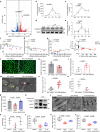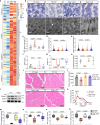Elevated levels of S100A8 and S100A9 exacerbate muscle mitochondrial fragmentation in sepsis-induced muscle atrophy
- PMID: 40021770
- PMCID: PMC11871300
- DOI: 10.1038/s42003-025-07654-3
Elevated levels of S100A8 and S100A9 exacerbate muscle mitochondrial fragmentation in sepsis-induced muscle atrophy
Abstract
Sepsis-induced skeletal muscle atrophy is common in septic patients with the increases risk of mortality and is associated with myocellular mitochondrial dysfunction. Nevertheless, the specific mechanism of sepsis muscle atrophy remains unclear. Here we conducted a clinical retrospective analysis and observed the elevation of skeletal muscle index (ΔSMI) was an independent risk factor for 60-day mortality in septic patients. Moreover, in mouse model of sepsis, the skeletal muscle atrophy was also observed, which was associated with the upregulation of S100a8/a9-mediated mitochondrial dysfunction. Inhibition of S100a8/a9 significantly improved mitochondrial function and alleviated muscle atrophy. Conversely, administration of recombinant S100a8/a9 protein exacerbated mitochondrial energy exhaustion and myocyte atrophy. Mechanistically, S100a8/a9 binding to RAGE induced Drp1 phosphorylation and mitochondrial fragmentation, resulting in muscle atrophy. Additionally, RAGE ablation or administration of Drp1 inhibitor significantly reduced Drp1-mediated mitochondrial fission, improved mitochondrial morphology and function. Our findings indicated the pivotal role of S100a8/a9 in driving the mitochondrial fragmentation in septic muscle atrophy. Targeting S100a8/a9-RAGE-initiated mitochondrial fission might offer a promising therapeutic intervention against septic muscle atrophy.
© 2025. The Author(s).
Conflict of interest statement
Competing interests: The authors declare no competing interests.
Figures







References
MeSH terms
Substances
Grants and funding
LinkOut - more resources
Full Text Sources
Medical
Miscellaneous

